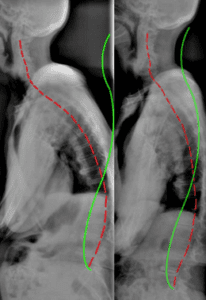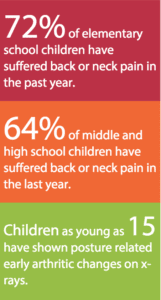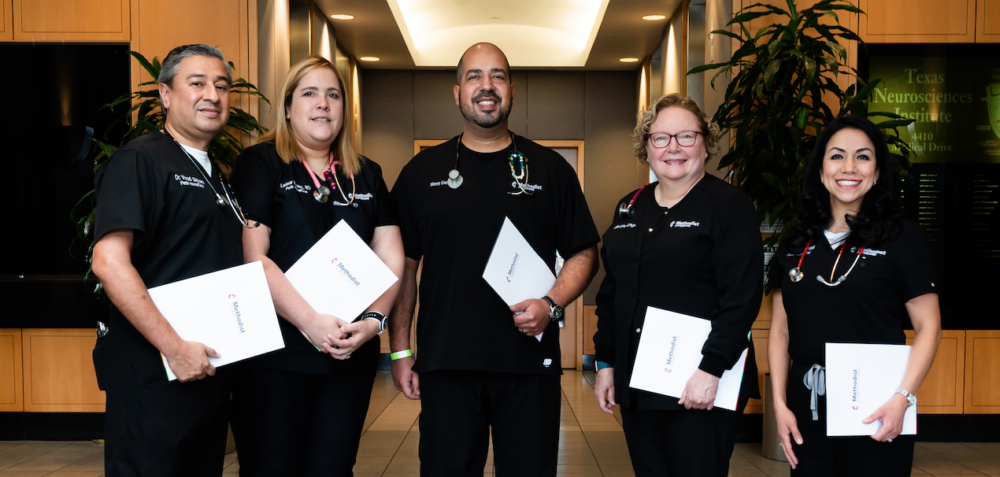When allowing and encouraging our children to use new technology, we also put them at risk. Children are using computers, tablets, and smartphones in ways that would not be acceptable for adults in the workplace. These activities pose serious threats to long-term health. As technology has raced ahead, offering us lots of amazing devices that can do
incredible things, our understanding of what their long-term use can do to our bodies has failed to keep pace. The worst problems stem from poor posture and the resulting strain from repetitive movements when using the devices over long periods of time.
“Smartphone thumb” and “laptop neck” have replaced tennis elbow and carpal tunnel syndrome. Chronic back and neck pain, a shocking blight on people’s lives, is now being seen among children of elementary school age in increasing numbers.
Most of these problems can be attributed to the careless use of technology, poor posture and some aspects of manual handling, such as carrying overloaded school bags. The problem is more alarming in children because their bodies are still developing. Unless we do something right now, more and more children will grow up with the kind of discomfort and pain more prevalent in much older people.
“An average 8- to 18-years-old child spends over 7.5 hours per day on smart devices in extremely poor postures; a likely cause of biomechanical and structural damages to their growing bodies.” -Dr. Romina Ghassemi, D.C.
Unfortunately, many adults experience neck, back and wrist pain while working on their computers. We often find ourselves pushing away from our devices to stretch, move or take a break in order to find relief. It doesn’t take long when working on our laptops, desktop computers or smart devices before we start to experience some levels of discomfort.
 Now, think about typical children and young people. How long do they work or play on their devices, and how good is their posture? Most children will play with digital technology for hours without even thinking about taking a break, and they will often be sitting in the most inappropriate positions on unsuitable furniture or the floor.
Now, think about typical children and young people. How long do they work or play on their devices, and how good is their posture? Most children will play with digital technology for hours without even thinking about taking a break, and they will often be sitting in the most inappropriate positions on unsuitable furniture or the floor.
Children don’t feel discomfort the way older people do. They believe they are invincible, and the idea that they may be at risk from musculoskeletal disorders (MSDs) will not enter their heads. To them, the absence of discomfort equals absence of risk. But there is growing evidence that this is a serious mistake.
Most organizations have recognized that poor posture among office employees can lead to increased absenteeism, decreased performance and an increased risk of injury. MSDs can arise from prolonged static postures; the worse the posture and the longer this posture is held, the greater the risk of an MSD developing.
 “Wolf’s law states that bone in a healthy person or animal will adapt to the loads under which it is placed. Hence poor posture as repetitive injury will change structure [bones and joints]. Muscle pain, tendon, and ligament weakness are explained by Davis’ law which describes how soft tissue molds along imposed demands. It is the corollary to Wolf’s law, which applies to osseous tissue. In summary, when you visibly see a child’s posture change, Wolf’s and Davis’ law are already in effect of MSD. I see this frequently in my clinic. These youth postures are more prone to negative impact to MSD at developmental ages and adulthood. The good news is early detection and a few simple modifications will not only help reduce the damages but in some cases, it stops the rate of degeneration. In my clinic, we focus on correcting the underlying causes of poor posture. During a correction program one can easily see a child’s attitude and self-confidence improve along with their pain and posture,” Dr. Romina Ghassemi explained in detail.
“Wolf’s law states that bone in a healthy person or animal will adapt to the loads under which it is placed. Hence poor posture as repetitive injury will change structure [bones and joints]. Muscle pain, tendon, and ligament weakness are explained by Davis’ law which describes how soft tissue molds along imposed demands. It is the corollary to Wolf’s law, which applies to osseous tissue. In summary, when you visibly see a child’s posture change, Wolf’s and Davis’ law are already in effect of MSD. I see this frequently in my clinic. These youth postures are more prone to negative impact to MSD at developmental ages and adulthood. The good news is early detection and a few simple modifications will not only help reduce the damages but in some cases, it stops the rate of degeneration. In my clinic, we focus on correcting the underlying causes of poor posture. During a correction program one can easily see a child’s attitude and self-confidence improve along with their pain and posture,” Dr. Romina Ghassemi explained in detail.
As young people enter the labor force, we are seeing more and more 20-somethings with back, neck and wrist issues. They may have been playing and working with computers and smart devices for 10 years. They have formed bad habits and adopted poor postures. Now, consider that children at 3-years-old are using tablets and smart devices every day. How much damage will have been inflicted on their bodies when they enter the job market in 18 to 20 years?
Cardinus Risk Managementsurveyed more than 250 students in British primary and secondary schools. The survey found that more than 50 percent of 14-year-olds have back pain. Back pain! They are already in trouble, and because of social media, school work and gaming, our children spend way more time interacting with technology than adults do at work. Prolonged use and prolonged poor posture; we need to make some serious changes to help our children.
Cardinus has developed training material and guides to help you educate your children and improve their posture. Our program helps children recognize discomfort and understand that it is their body’s way of letting them know it is time to make a change, take a break or stretch. Cardinus and Bax-U work together to provide solutions to reverse the muscle memory from prolonged poor postures and provide eLearning to re-enforce correct behavior.
For more information visit www.ergo4students.com, www.bax-u.com and www.cardinus.com.







Recent Comments